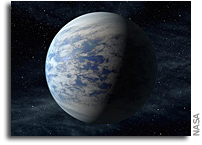Atmospheric Tides In Earth-like Planets

Atmospheric tides can strongly affect the rotational dynamics of planets. In the family of Earth-like planets, such as Venus, this physical mechanism coupled with solid tides makes the angular velocity evolve over long timescales and determines the equilibrium configurations of their spin.
Contrary to the solid core, the atmosphere is submitted to both tidal gravitational potential and insolation flux coming from the star. The complex response of the gas is intrinsically linked to its physical properties. This dependence has to be characterized and quantified to study the large variety of extrasolar planetary systems. We develop a theoretical global model where radiative losses, which are predominant in slowly rotating atmospheres, are taken into account. We analytically compute the tidal perturbation of pressure, density, temperature and velocity field from which we deduce the expressions of atmospheric Love numbers and tidal torque exerted by the star. The dynamics of atmospheric tides depends on the frequency regime of the tidal perturbation: the thermal regime near synchronization and the dynamical regime characterizing fast-rotating planets.
The dependence of the torque on the tidal frequency is quantified for Earth-like and Venus-like exoplanets and is in good agreement with the results given by Global Climate Models (GCM) simulations. Introducing dissipative processes such as radiation regularizes the tidal response of the atmosphere, otherwise it is singular at synchronization. We demonstrate the important role played by the physical and dynamical properties of a super-Earth atmosphere (e.g. Coriolis, stratification, background pressure, density, temperature, radiative emission) and point out the key parameters defining tidal regimes (e.g. inertia, Brunt-V\”ais\”al\”a, radiative frequencies, tidal frequency) and characterize the behaviour of the fluid shell with dissipation.
Pierre Auclair-Desrotour, Jacques Laskar, Stéphane Mathis
(Submitted on 15 Nov 2016)
Comments: 43 pages, 29 figures, accepted for publication in Astronomy & Astrophysics, 85 Astronomy and Astrophysics
Subjects: Earth and Planetary Astrophysics (astro-ph.EP)
Cite as: arXiv:1611.04806 [astro-ph.EP] (or arXiv:1611.04806v1 [astro-ph.EP] for this version)
Submission history
From: Pierre Auclair-Desrotour
[v1] Tue, 15 Nov 2016 12:34:36 GMT (10564kb,D)
https://arxiv.org/abs/1611.04806








